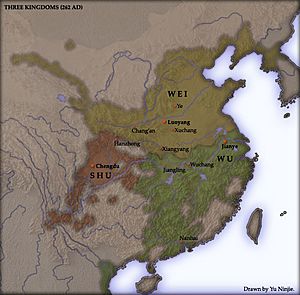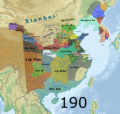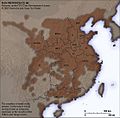Three Kingdoms facts for kids
The Three Kingdoms was an important time in the history of Ancient China. This period lasted from about 220 AD to 280 AD. During these years, China was not united under one ruler. Instead, it was split into three main kingdoms: Wei, Shu Han, and Wu.
Before this, China was ruled by the Han dynasty. After the Han dynasty ended, these three powerful groups emerged. However, none of them were strong enough to defeat the other two and unite all of China right away.
The last emperor of the Han dynasty, Emperor Xian, gave up his power in the year 220 AD. He handed it over to a powerful leader named Cao Pi. The Three Kingdoms period officially began then. It ended when a new dynasty, the Jin dynasty, managed to unite China again in 280 AD. This new ruler was called Emperor Wu of Jin.
Some historians believe the Three Kingdoms period actually started earlier, around 189 AD. This is because the central government of the Han dynasty lost most of its control around that time. Local warlords became very powerful, and the country began to break apart even before the emperor officially stepped down.
Contents
The End of the Han Dynasty
A Time of Trouble
The Han dynasty had ruled China for a very long time. But by the late 100s AD, it was getting weak. There were many problems, like corrupt officials and powerful warlords fighting each other. These warlords were military leaders who controlled different parts of the country. They often ignored the emperor.
In 189 AD, a big event happened. The capital city, Luoyang, was attacked. This made the emperor even weaker. From this point on, the central government had very little power. China began to break into many smaller areas controlled by different warlords. This set the stage for the Three Kingdoms.
The Rise of New Powers
Among these many warlords, three became the most powerful. They were Cao Cao, Liu Bei, and Sun Quan. Each of them controlled a large part of China. They fought many battles against each other.
- Cao Cao controlled the northern parts of China. His son, Cao Pi, later founded the Kingdom of Wei.
- Liu Bei controlled the western parts. He founded the Kingdom of Shu Han.
- Sun Quan controlled the southern and eastern parts. He founded the Kingdom of Wu.
These three leaders and their families would go on to establish the three main kingdoms.
The Three Main Kingdoms
The Kingdom of Wei
The Kingdom of Wei was founded by Cao Pi in 220 AD. It was located in the north of China. Wei was the strongest of the three kingdoms. It had the most land and the largest population. Its capital city was Luoyang.
Wei was known for its strong army and its smart leaders. Many famous generals and strategists served Wei. They often fought against the other two kingdoms to try and unite China.
The Kingdom of Shu Han
The Kingdom of Shu Han was founded by Liu Bei in 221 AD. It was located in the southwest of China, in what is now Sichuan province. Liu Bei claimed to be a true descendant of the Han imperial family. He believed he was the rightful ruler of all China.
Shu Han was smaller than Wei. However, it had a very famous military strategist named Zhuge Liang. He was known for his incredible intelligence and clever plans. Shu Han often formed alliances with Wu to fight against the stronger Wei.
The Kingdom of Wu
The Kingdom of Wu was founded by Sun Quan in 229 AD. It was located in the southeast of China, along the Yangtze River. Wu was known for its strong navy and its ability to control the waterways. Its capital city was Jianye (modern-day Nanjing).
Wu had a strong economy, especially through trade along the rivers. It was often involved in battles with both Wei and Shu Han. The famous Battle of Red Cliffs, where Wu and Shu Han forces defeated Cao Cao's much larger army, was a key moment for Wu.
Life During the Three Kingdoms
Life during this period was often difficult for ordinary people. There were constant wars and battles. Many people were displaced from their homes. However, it was also a time of great change and new ideas.
Despite the wars, there were also advancements in technology and culture. For example, new farming methods were developed. People also created beautiful art and literature. The story of the Three Kingdoms has inspired many famous novels, plays, and movies in China.
The End of the Three Kingdoms
The Three Kingdoms period ended when the Jin dynasty united China. The Jin dynasty was founded by Sima Yan, who was a general from the Kingdom of Wei. In 263 AD, Wei conquered Shu Han. Then, in 265 AD, Sima Yan took power from Wei and established the Jin dynasty.
Finally, in 280 AD, the Jin dynasty conquered the Kingdom of Wu. This brought an end to the long period of division. China was once again united under a single emperor. The Three Kingdoms period is remembered as a time of heroes, battles, and clever strategies in Chinese history.
Images for kids
-
Bronze turtle holding a cup, Eastern Wu
-
Zhuge Liang's Southern Campaign
-
Zhuge Liang's first and second northern expeditions against Cao Wei
-
Cao Zhi as depicted in Goddess of Luo River (detail) by Gu Kaizhi, Jin dynasty, China
-
Pottery dwelling around a large courtyard, a siheyuan. Unearthed in 1967 in a tomb of Hubei built during the kingdom of Eastern Wu, Three Kingdoms period, National Museum of China, Beijing
See also
 In Spanish: Tres Reinos para niños
In Spanish: Tres Reinos para niños













